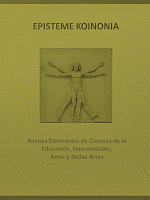Mejora de la habilidad oral de los estudiantes de EFL mediante tareas académicas de expresión oral en el nivel de secundaria
DOI:
https://doi.org/10.35381/e.k.v5i9.1663Keywords:
Expresión oral, educación de la expresión oral, educación cultural. (Tesauro UNESCO).Abstract
Una de las mayores preocupaciones de los profesores de inglés como lengua extranjera (EFL) es conseguir que los estudiantes interactúen en el aula; en este sentido, este estudio analizó las percepciones sobre las estrategias específicas para mejorar la habilidad de expresión oral que utilizan los alumnos de la Unidad Educativa "Ramona Auxiliadora Marcillo Chica". Para recoger los datos se utilizó un cuestionario, los resultados mostraron cómo los estudiantes aprenden inglés y qué estrategias utilizan para este fin; asimismo, el análisis de datos indica los niveles de compromiso, autonomía, y cierta indiferencia respecto al aprendizaje de EFL. Esto nos lleva a concluir que, los estudiantes pueden mejorar sus habilidades orales siempre y cuando los profesores de inglés implementen estrategias y metodologías efectivas en el aula, como la lectura en voz alta y el uso de canciones, lo cual permitirá que los estudiantes mejoren su habilidad oral con precisión y espontaneidad.
Downloads
References
Bahrani, T., & Soltani, R. (2012). How to teach speaking skill. Journal of Education and Practice, 3(2), 25-29.
Birch, B. M., & Fulop, S. (2020). English L2 Reading: Getting to the bottom. Routledge, 4th Edition. https://doi.org/10.4324/9780429397783
Brown, S. (2005). Assessment for learning. Learning and teaching in higher education, 1, 81–89.
Buhari, B. (2019). Practicing Discussion in the Form of Pyramid to Improve Students’ Speaking Performance and Classroom Interaction. Journal of Languages and Language Teaching, 7(2), 108-116. https://doi.org/10.33394/jollt.v7i2.1958
Calle, A., Calle, S., Argudo, J., Moscoso, E., Smith, A., & Cabrera, P. (2012). Los profesores de inglés y su práctica docente: Un estudio de caso de los colegios fiscales de la ciudad de Cuenca, Ecuador. MASKANA, 3(2), 1–17. https://doi.org/10.18537/mskn.03.02.01
Chomsky, N. (1965). Persistent Topics in Linguistic Theory. Diogenes, 13(51), 13–20. https://doi.org/10.1177/039219216501305102
Chomsky, N. (1980). Rules and representations. Behavioral and Brain Sciences, 3(1), 1–15. https://doi.org/10.1017/s0140525x00001515
Dörnyei, Z. (2003). Attitudes, Orientations, and Motivations in Language Learning: Advances in Theory, Research, and Applications. Language Learning, 53(S1), 3–32. https://doi.org/10.1111/1467-9922.53222
Duarte, M., Tinjacá Bernal, L. M., & Carrero Olivares, M. (2012). Using songs to encourage sixth graders to develop English speaking skills. Profile Issues in Teachers Professional Development, 14(1), 11-28.
Education First. (2021). The world's largest ranking of English language proficiency. With data from 2 million participants in 112 countries and regions. Retrieved from https://www.ef.com.ec/epi/
Franco, P. (2012). Características psicométricas de un cuestionario en español para medir estrategias de aprendizaje del inglés como lengua extranjera [Psychometric characteristics of a Spanish-language questionnaire to measure English as a foreign language learning strategies]. Porta Linguarum Revista Interuniversitaria de Didáctica de las Lenguas Extranjeras. https://doi.org/10.30827/digibug.30919
Field, A. (2018). Discovering Statistics Using IBM SPSS Statistics. https://n9.cl/bbal7
Gibson, S. (2008). Reading aloud: a useful learning tool? ELT Journal, 62(1), 29–36. https://doi.org/10.1093/elt/ccm075
Harmer, J. (2001). The Practice of English Language Teaching (3rd Completely Revised, Updated ed.). Addison Wesley Publishing Company.
Jiménez, P. K. (2018). Exploring Students’ Perceptions About English Learning in a Public University. HOW, 25(1), 69–91. https://doi.org/10.19183/how.25.1.385
Kassem, M. A. M. (2018). Improving EFL Students’ Speaking Proficiency and Motivation: A Hybrid Problem-based Learning Approach. Theory and Practice in Language Studies, 8(7), 848-859. https://doi.org/10.17507/tpls.0807.17
Krashen, S. D. (1982). Principles and Practice in Second Language Acquisition (Language Teaching Methodology Series) by Krashen, Stephen D. (1982) Paperback (1st ed.). Pergamon Press. https://n9.cl/wds3
Krashen, S. D. (1991). The Input Hypothesis: Issues and Implications (1st ed.). Laredo Pub Co. https://n9.cl/thkvg
Lovia Boateng, D. S. L. (2018). Structural Equation Modelling Made Easy for Business and Social Science Research Using SPSS and AMOS.
McCarthy, J. (2006). Songs in the classroom Jamie McCarthy. teflcourse.net. Retrieved from https://n9.cl/vxfci
Mizener, C. P. (2008). Enhancing Language Skills Through Music. General Music Today, 21(2), 11–17. https://doi.org/10.1177/1048371308316414
Morales, C. (2008). Using rock music as a teaching-learning tool. Profile Issues in Teachers Professional Development, (9), 163-180.
Muslem, A., Zulfikar, T., & Asrila, I. (2017). Students’ perception of oral corrective feedback in speaking classes. English Education Journal, 8(3), 275–291.
Orlova, N. (2003). Helping Prospective EFL teachers learn how to use songs in teaching conversation classes. The internet TESL journal, 9(3), 12-15.
Patrick, R. (2019). Comprehensible Input and Krashen’s theory. Journal of Classics Teaching, 20(39), 37–44. https://doi.org/10.1017/s2058631019000060
Philips, S. (1993). Young Learner: Songs and chants. Oxford University Press. https://n9.cl/iafyb
Riadil, I. G. (2020). EFL Students in Speaking Skill: Identifying English Education Students’ Perceptions of the Psychological Problems in Speaking. JETAL: Journal of English Teaching & Applied Linguistic, 2(2), 8–20. https://doi.org/10.36655/jetal.v2i2.266
Richards, J. C., & Schmidt, R. (2002). Longman dictionary of applied linguistics and language teaching. Longman. https://n9.cl/687vr
Stanovich, K. E. (1991). Changing models of reading and reading acquisition. In L. Rieben & C. A. Perfetti (Eds.), Learning to read: Basic research and its implications (pp. 19–31). Lawrence Erlbaum Associates, Inc
Thornbury, S. (2005). How to Teach Speaking (1.a ed.). Pearson Educación.
Published
How to Cite
Issue
Section
License
CC BY-NC-SA : Esta licencia permite a los reutilizadores distribuir, remezclar, adaptar y construir sobre el material en cualquier medio o formato solo con fines no comerciales, y solo siempre y cuando se dé la atribución al creador. Si remezcla, adapta o construye sobre el material, debe licenciar el material modificado bajo términos idénticos.
OAI-PMH URL: https://fundacionkoinonia.com.ve/ojs/index.php/epistemekoinonia/oai







